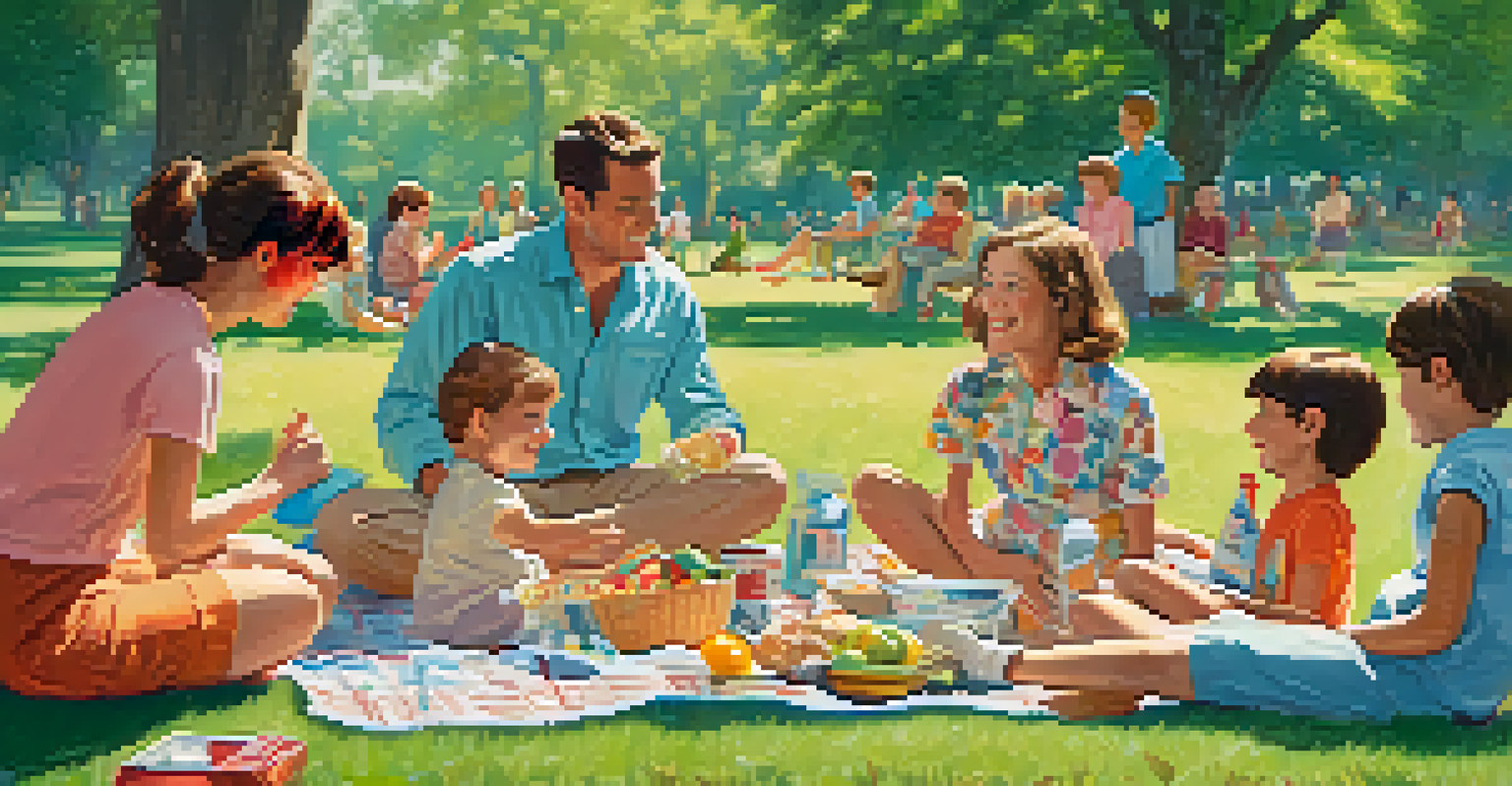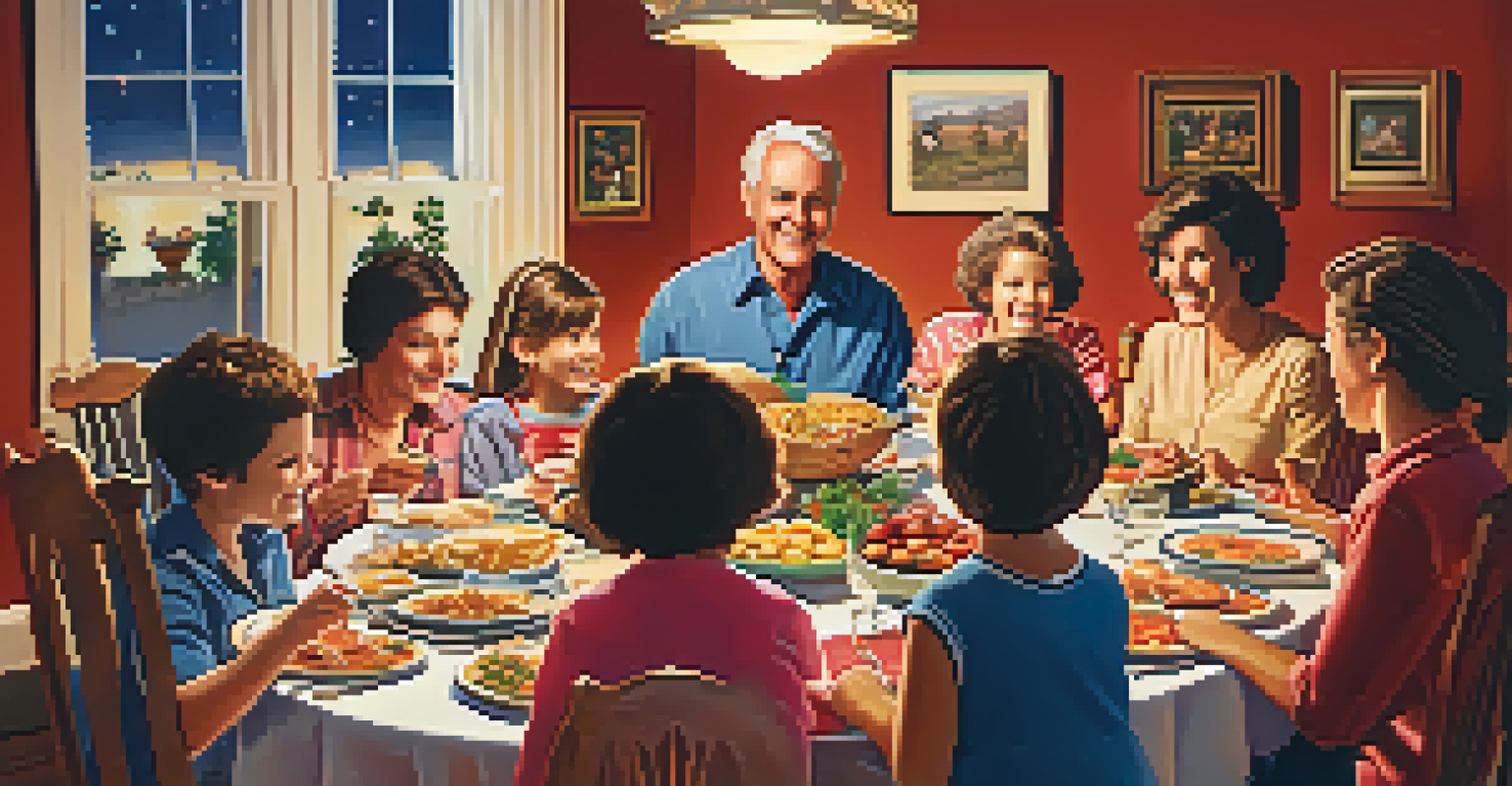Cinematic Portrayals of Family Dynamics Over the Decades

The 1950s: Idealized Families in Post-War Cinema
The 1950s brought a wave of films that depicted the quintessential family, often portraying a picture-perfect domestic life. Movies like 'Leave It to Beaver' and 'Father Knows Best' showcased traditional family structures, emphasizing harmony and moral values. This idealization was a response to the societal shifts following World War II, where stability was sought after in the home. However, beneath this polished surface, there were often underlying tensions and complexities that hinted at the realities of family life.
Cinema has the power to reflect the realities of our lives, capturing both the joys and struggles of family dynamics.
These films often reflected the American Dream, portraying fathers as providers and mothers as homemakers, creating a sense of nostalgia for simpler times. The characters were often placed in scenarios that reinforced family unity, making the audience yearn for that same level of connection. While these portrayals were comforting, they also glossed over the struggles that many families faced, such as economic hardship and the pressure to conform.
In this era, the cinematic lens was focused on portraying family values and the notion of togetherness, ultimately setting a template for how families would be viewed in future films. This emphasis on idealism would evolve, paving the way for more nuanced representations in the following decades.
The 1960s: Challenging Norms and Exploring Diversity
As the 1960s rolled in, filmmakers began to challenge the traditional family dynamics portrayed in previous decades. The rise of counterculture and social movements encouraged a more diverse representation of families, including single parents and mixed-race households. Films like 'Guess Who's Coming to Dinner' tackled racial tensions and showcased the evolving landscape of family relationships, reflecting the changing societal norms.

This era also introduced the concept of the 'nuclear family' being questioned. The complexities of marriage, divorce, and parenting were explored in films, highlighting the struggles that many faced, rather than just the idyllic picture. The portrayal of family dynamics began to embrace imperfections, allowing audiences to connect more deeply with the characters' journeys.
Cinema's Evolution of Family Dynamics
Over the decades, films have shifted from idealized portrayals of families to more complex and diverse representations reflecting societal changes.
Through humor and drama, filmmakers provided a more authentic lens on family life, resonating with viewers who were experiencing similar challenges. This shift marked a significant turning point, as cinema started to recognize and celebrate the diversity of family structures.
The 1970s: Realism and the Rise of Dysfunctional Families
The 1970s ushered in an era of realism, with films focusing on the complexities and dysfunctions of family life. Movies like 'The Godfather' and 'Ordinary People' presented families that were far from perfect, showcasing internal conflicts and emotional struggles. This decade emphasized the idea that families could be both supportive and toxic, often in the same breath, providing a more relatable narrative for viewers.
Family is not an important thing, it's everything.
Dysfunctional family dynamics became a popular theme, with filmmakers delving into issues such as addiction, mental health, and communication breakdowns. By presenting characters who grappled with these challenges, audiences found themselves reflecting on their own family experiences. This shift to realism served not only as entertainment but also as a catalyst for conversations about family issues that were often left unspoken.
The portrayal of family in the 1970s laid the groundwork for future films to explore even deeper emotional landscapes. This decade showcased that family dynamics are rarely black and white, and that the tumultuous journey of familial relationships is a universal experience.
The 1980s: Family Comedies and the Return of Lightheartedness
After the heavy themes of the previous decade, the 1980s brought a wave of family comedies that sought to lighten the mood. Movies like 'Home Alone' and 'The Breakfast Club' embraced humor while still addressing family issues, albeit in a more palatable way. This era showcased the importance of connection and love, often placing characters in humorous situations that tested their family bonds.
Comedies often highlighted the importance of individuality within the family unit, allowing characters to explore their identities while still emphasizing the value of family support. The blend of humor and heart made these films relatable, inviting audiences to laugh while also reflecting on their own family dynamics. The mix of quirky characters and heartfelt moments created a balance that resonated with viewers.
Diversity and Inclusion in Family Stories
The 2010s and beyond have seen an emphasis on diverse family structures, including LGBTQ+ families, broadening the narrative landscape in cinema.
While the tone was lighter, the 1980s still addressed important themes such as growing up, peer pressure, and the challenges of parenting. This decade proved that family dynamics could be both complicated and enjoyable, paving the way for a new generation of films that continued to explore these themes.
The 1990s: The Rise of Blended Families and New Narratives
The 1990s introduced a surge of films that prominently featured blended families and non-traditional family structures. Movies like 'The Parent Trap' and 'Mrs. Doubtfire' explored themes of divorce, remarriage, and the challenges that come with combining families. This decade began to normalize the idea that families could take many forms, reflecting the realities of many viewers' lives.
In addition to blended families, the 1990s also saw a focus on friendships that felt like family, showcasing the importance of chosen family in a person's life. Films like 'Friends' and 'The Fresh Prince of Bel-Air' highlighted the role of close friends who became integral support systems, emphasizing that family does not always have to be biological. This shift allowed for a broader exploration of love and loyalty.
As the decade progressed, filmmakers embraced storytelling that was inclusive and relatable, paving the way for future narratives. The 1990s set a precedent for acknowledging the diversity of family dynamics, highlighting that love and connection can flourish in various forms, regardless of traditional expectations.
The 2000s: Families in Crisis and Social Commentary
The 2000s continued the trend of exploring complex family dynamics, often focusing on families in crisis. Films like 'Little Miss Sunshine' and 'The Pursuit of Happyness' depicted the struggles of families facing economic hardships and personal challenges. This decade showcased the resilience of familial bonds, even in the face of adversity, resonating with audiences who were experiencing similar struggles.
Social commentary became a prominent theme, with filmmakers using family narratives to address larger societal issues such as inequality, mental health, and the impact of technology on relationships. By intertwining personal stories with broader themes, these films provided a platform for discussion and reflection, encouraging viewers to think critically about their own family dynamics.
Realism in Family Challenges
The 1970s and 2000s marked significant turns in film, highlighting the struggles and complexities of family life, making it relatable for audiences.
Through a mix of drama and humor, the 2000s highlighted the importance of support and understanding within families. This era reinforced the idea that while families might face significant challenges, the love and connection shared can often be the driving force that helps them navigate through tough times.
The 2010s and Beyond: Diverse Representations and New Perspectives
The 2010s marked a significant shift in the portrayal of family dynamics, with an emphasis on diversity and inclusion. Films like 'Moonlight' and 'The Farewell' explored different cultural backgrounds, identities, and experiences, showcasing a rich tapestry of family life. This decade celebrated the uniqueness of each family's story, broadening the narrative landscape of cinema.
Moreover, there was a growing recognition of LGBTQ+ families, with films like 'Love, Simon' and 'The Kids Are All Right' highlighting the importance of acceptance and love in all its forms. These stories contributed to a more holistic understanding of what family can mean, allowing for greater representation on screen. The focus on authenticity resonated deeply with audiences, fostering a sense of belonging.

As we move into the future, cinematic portrayals of family dynamics will likely continue to evolve, reflecting the ever-changing landscape of society. The importance of inclusivity and representation in storytelling ensures that a variety of family experiences will be shared, ultimately enriching our understanding of what it means to be a family.